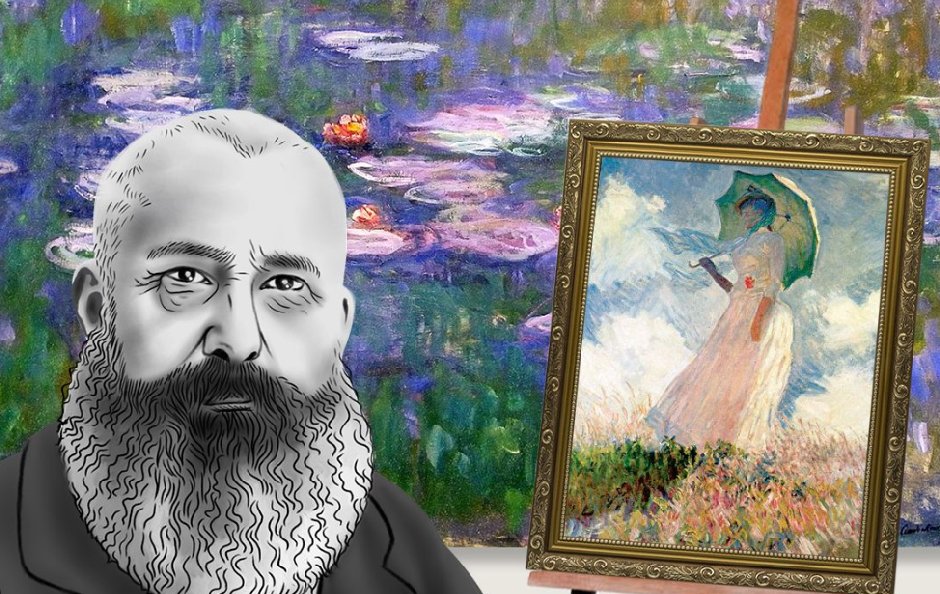Claude Monet, the French Impressionist master, remains one of the most renowned artists in history, celebrated for his groundbreaking contributions to the world of art. Delving into the life and works of Monet unveils a rich tapestry of talent, innovation, and profound influence that continues to inspire generations. Here are 24 captivating facts shedding light on the brilliance of Claude Monet.
Early Years: Oscar-Claude Monet was born on November 14, 1840, in Paris, France. Raised in Le Havre, Monet displayed an early affinity for art, sketching charcoal caricatures of locals by the age of 15.
Military Service: Monet’s artistic pursuits were momentarily interrupted when he was drafted into the French army in 1861. However, he was later released from service due to health reasons, allowing him to focus entirely on his passion for painting.
The Birth of Impressionism: Alongside fellow artists such as Pierre-Auguste Renoir and Camille Pissarro, Monet played a pivotal role in the development of Impressionism, a movement characterized by capturing the fleeting effects of light and atmosphere.
Monet’s painting, “Impression, Sunrise”, exhibited in 1874, gave the Impressionist movement its name. The artwork depicted the port of Le Havre at sunrise, showcasing Monet’s mastery in conveying light and atmosphere.
Artistic Vision: Monet’s distinctive style focused on capturing the essence of a scene rather than its precise details. He often painted en plein air, directly observing and interpreting nature’s beauty.
Giverny: In 1883, Monet moved to Giverny, a picturesque village in northern France, where he would spend the rest of his life. The idyllic surroundings of Giverny inspired many of his iconic works.
Water Lilies: One of Monet’s most famous series, the Water Lilies, comprises approximately 250 oil paintings, capturing the serene beauty of his water garden at Giverny. These paintings are considered masterpieces of the Impressionist movement.
Japanese Influence: Monet was deeply influenced by Japanese art, particularly its emphasis on nature and simplicity. This influence is evident in his composition and use of color in many of his works.
Haystacks and Rouen Cathedral: Monet’s series on haystacks and Rouen Cathedral exemplify his fascination with capturing the effects of light and weather on a single subject at different times of the day.
Financial Struggles: Despite his eventual fame, Monet faced financial difficulties throughout his life. He often struggled to sell his paintings and relied on the support of patrons and dealers.
Family Life: Monet married Camille Doncieux in 1870, and they had two sons together, Jean and Michel. Tragically, Camille passed away in 1879, leaving Monet devastated.
Second Marriage: In 1892, Monet married Alice Hoschedé, a friend and supporter during his challenging times. Alice played a significant role in managing Monet’s affairs and supporting his artistic endeavors.
Theatre of Light: Monet’s series of paintings featuring the iconic facade of the Rouen Cathedral showcases his fascination with capturing the interplay of light and architecture. Each painting in the series offers a unique perspective on the cathedral’s grandeur.
Influence on Modern Art: Monet’s innovative techniques and exploration of color and light laid the groundwork for many subsequent art movements, including Post-Impressionism and Abstract Expressionism.
Eye Troubles: Monet developed cataracts in his later years, which significantly affected his vision and perception of color. Despite this challenge, he continued to paint prolifically, adapting his techniques to accommodate his visual impairment.
Artistic Legacy: Monet’s legacy extends far beyond his lifetime, with his works continuing to inspire and influence artists and art enthusiasts worldwide. His contributions to the art world are celebrated in museums and galleries around the globe.
International Recognition: Monet’s artistic genius earned him international acclaim during his lifetime, with exhibitions of his work held in major cities across Europe and the United States.
Documentary Films: Several documentary films have been made about Monet’s life and works, offering insights into his artistic process, personal struggles, and enduring legacy.
Iconic Masterpieces: Monet’s oeuvre includes a vast array of iconic masterpieces, ranging from tranquil landscapes and vibrant garden scenes to dynamic cityscapes and captivating portraits.
Art Market Success: Today, Monet’s paintings are among the most sought-after and valuable works in the art market, fetching millions of dollars at auctions and private sales.
Public Collections: Monet’s paintings adorn the walls of prestigious public collections worldwide, including the Musée d’Orsay in Paris, the Metropolitan Museum of Art in New York City, and the National Gallery in London.
Artistic Evolution: Throughout his career, Monet’s style evolved, reflecting his ongoing experimentation with color, brushwork, and composition. His willingness to innovate and push artistic boundaries remains an enduring hallmark of his legacy.
Lasting Influence: Monet’s impact on the art world transcends generations, with artists from diverse backgrounds drawing inspiration from his innovative techniques and profound connection to nature.
Enduring Inspiration: As admirers of Monet’s timeless creations, art enthusiasts can explore his mesmerizing world and even bring a piece of it into their homes. For example, you can purchase high-quality reproductions of the “Wild Poppies Near Argenteuil” artwork here.
Nature’s Symphony: Monet’s profound connection to nature is palpable in his vibrant depictions of landscapes, gardens, and seascapes. His ability to capture the ever-changing nuances of light and color imbues his paintings with a sense of vitality and harmony that resonates with viewers.
Legacy of Inspiration: Claude Monet’s enduring legacy extends beyond the realm of art, influencing not only painters but also poets, musicians, and writers. His ability to evoke emotion and capture the essence of fleeting moments continues to inspire creativity and appreciation for the beauty of the natural world.





